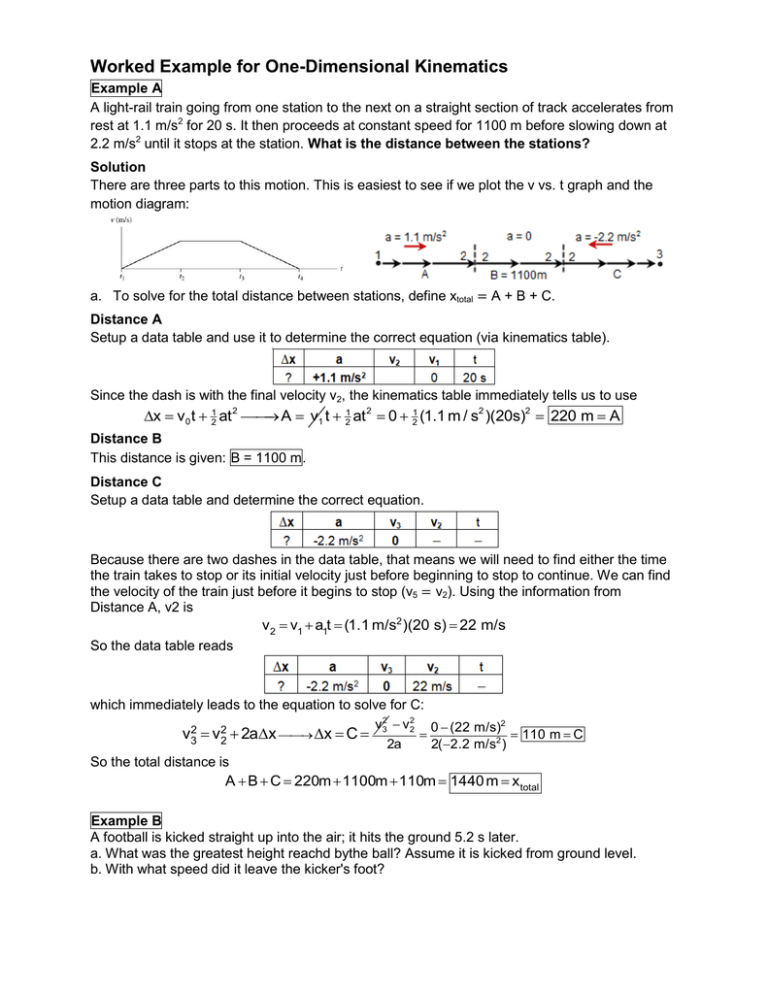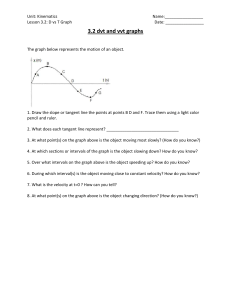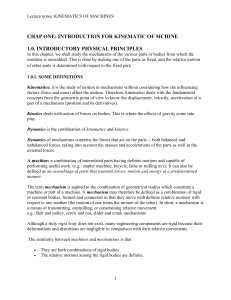Worked Example for One-Dimensional Kinematics
advertisement

Worked Example for One-Dimensional Kinematics Example A A light-rail train going from one station to the next on a straight section of track accelerates from rest at 1.1 m/s2 for 20 s. It then proceeds at constant speed for 1100 m before slowing down at 2.2 m/s2 until it stops at the station. What is the distance between the stations? Solution There are three parts to this motion. This is easiest to see if we plot the v vs. t graph and the motion diagram: a. To solve for the total distance between stations, define xtotal = A + B + C. Distance A Setup a data table and use it to determine the correct equation (via kinematics table). Since the dash is with the final velocity v2, the kinematics table immediately tells us to use x v 0 t 21 at 2 A v1 t 21 at 2 0 21 (1.1 m / s2 )(20s)2 220 m A Distance B This distance is given: B = 1100 m. Distance C Setup a data table and determine the correct equation. Because there are two dashes in the data table, that means we will need to find either the time the train takes to stop or its initial velocity just before beginning to stop to continue. We can find the velocity of the train just before it begins to stop (v5 = v2). Using the information from Distance A, v2 is v2 v1 a1t (1.1 m/s2 )(20 s) 22 m/s So the data table reads which immediately leads to the equation to solve for C: 2 v2 v2 v32 v22 2ax x C 3 2 0 (22 m/s)2 110 m C 2a 2(2.2 m/s ) So the total distance is A B C 220m 1100m 110m 1440 m x total Example B A football is kicked straight up into the air; it hits the ground 5.2 s later. a. What was the greatest height reachd bythe ball? Assume it is kicked from ground level. b. With what speed did it leave the kicker's foot? Solution a. Assume the trajectory is symmetric (i.e., the ball leaves the ground) so half of the total time is the upward portion and half downward. That is, the time to the peak of the trajectory is half of the total time: tpeak = 2.6 s. This is key: we can look at the motion going up or coming down. In this problem we look at the motion coming down. Draw a motion diagram and setup a data table. Since the dash is with the initial velocity v1, the kinematics table immediately tells us to use y y 2 y1 v1t 21 at 2 0 y1 v1 t 21 gt 2 y1 21 (9.81 m / s2 )(2.6s)2 33 m y1 b. If we now reverse the problem and think of it as going up only, then the final speed at the peak of the trajectory is zero. Setting up the data table leads to This means that we can use any equation; the easiest is v 4 v 3 gt v 3 gt (9.81 m / s2 )(2.6s)2 25 m/s v 3





